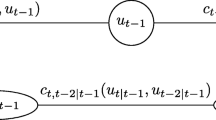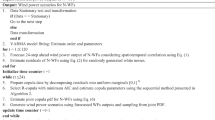Abstract
Synthetic streamflow data is vital for the energy sector, as it feeds stochastic optimisation models that determine operational policies. Considered scenarios should differ from each other, but be the same from a statistical point of view, i.e., the scenarios must preserve features of the original time series such as the mean, variance, and temporal dependence structures. Traditionally, linear models are applied for this task. Recently, the advent of copulas has led to the emergence of an alternative that overcomes the drawbacks of linear models. In this context, we propose a methodology based on vine copulas for the stochastic simulation of periodic streamflow scenarios. Copula-based models that focus on single-site inflow simulation only consider lag-one time dependence. Therefore, we suggest an approach that incorporates lags that are greater than one. Furthermore, the proposed model deals with the strong periodicity that is commonly present in monthly streamflow time series. The resulting model is a non-linear periodic autoregressive model. Our results indicate that this model successfully simulates scenarios, preserving features that are observed in historical data.







Similar content being viewed by others
References
Aas K, Czado C, Frigessi A, Bakken H (2009) Pair-copula constructions of multiple dependences. Insur Math Econ 44(2):182–198
Bedford T, Cooke RM (2001) Probability density decomposition for conditionally dependent random variables modeled by vines. Ann Math Artif Intell 32(1):245–268
Bedford T, Cooke RM (2002) Vines: a new graphical model for dependent random variables. Ann Stat 30(4):1031–1068
Brechmann EC, Czado C (2015) Copar-multivariate time series modeling using the copula autoregressive model. Appl Stoch Models Bus Ind 31(4):495–514
Chen X, Fan Y (2006) Estimation of copula-based semiparametric time series models. J Econom 130(2):307–335
Genest C, Favre AC (2007) Everything you always wanted to know about copula modeling but were afraid to ask. J Hydrol Eng 12(4):347–368
Grimaldi S, Serinaldi F (2006) Asymmetric copula in multivariate flood frequency analysis. Adv Water Resour 29(8):1155–1167
Hao Z, Singh VP (2011) Single-site monthly streamflow simulation using entropy theory. Water Resour Res 47(9):W09528. doi:10.1029/2010WR010208
Hao Z, Singh VP (2012) Entropy-copula method for single-site monthly streamflow simulation. Water Resour Res 48(6):W06604. doi:10.1029/2011WR011419
Jeong C, Lee T (2015) Copula-based modeling and stochastic simulation of seasonal intermittent streamflows for arid regions. J Hydro-Environment Res 9(4):604–613
Jimenez C, McLeod A, Hipel K (1989) Kalman filter estimation for periodic autoregressive-moving average models. Stoch Hydrol Hydraul 3(3):227–240
Joe H (1996) Families of m-variate distributions with given margins and m(m − 1)/2 bivariate dependence parameters. In: Distributions with fixed marginals and related topics, Lecture notes-monograph series, vol 28, Institute of Mathematical Statistics, pp 120–141
Joe H (2014) Dependence modeling with copulas. CRC Press, London
Kong XM, Huang GH, Fan YR, Li YP (2015) Maximum entropy-Gumbel-Hougaard copula method for simulation of monthly streamflow in Xiangxi River, China. Stoch Env Res Risk Assess 29(3):833–846
Kurowicka D, Cooke RM (2006) Uncertainty analysis with high dimensional dependence modeling. Wiley, London
Lee T, Salas JD (2011) Copula-based stochastic simulation of hydrological data applied to Nile River flows. Hydrol Res 42(4):318–330
Li C, Singh VP, Mishra KA (2013) Monthly river flow simulation with a joint conditional density estimation network. Water Resour Res 49(6):3229–3242
Mai JF, Scherer M (2012) Simulating copulas: stochastic models, sampling algorithms, and applications. World Scientific, Singapore
McNeil AJ, Frey R, Embrechts P (2010) Quantitative risk management: concepts, techniques, and tools. Princeton University Press, Princeton
Mendes BVM, Accioly VB (2014) Robust pair-copula based forecasts of realized volatility. Appl Stoch Models Bus Ind 30(2):183–199
Mendes BVM, Aíube C (2011) Copula based models for serial dependence. Int J Manag Financ 7(1):68–82
Pereira GAA, Souza RC (2014) Long memory models to generate synthetic hydrological series. Math Prob Eng 2014:823046. doi:10.1155/2014/823046
Salas JD, Delleur JW, Yevjevich JW, Lane WL (1980) Applied modeling of hydrologic time series. Water Resources Publications, Littleton, CO
Schepsmeier U, Stoeber J, Brechmann EC, Graeler B, Nagler T, Erhardt T (2015) VineCopula: statistical inference of vine copulas. http://CRAN.R-project.org/package=VineCopula, R package version 1.5
Sharma A, O’Neill R (2002) A nonparametric approach for representing interannual dependence in monthly streamflow sequences. Water Resour Res 38(7). doi:10.1029/2001WR000953
Sklar M (1959) Fonctions de répartition à n dimensions et leurs marges. Publ l’Inst Stat L’Univ Paris 8:229–231
Smith M, A M, Almeida C, Czado C (2012) Modeling longitudinal data using a pair-copula decomposition of serial dependence. J Am Stat Assoc 105(492):1467–1479
Smith MS (2015) Copula modelling of dependence in multivariate time series. Int J Forecast 31(3):815–833
Song S, Singh VP (2010) Frequency analysis of droughts using the plackett copula and parameter estimation by genetic algorithm. Stoch Environ Res Risk Assess 24(5):783–805
Song-Bai S, Kang Y (2011) Pair-copula decomposition constructions for multivariate hydrological drought frequency analysis. In: 2011 international symposium on water resource and environmental protection (ISWREP). IEEE, vol 4, pp 2635–2638
Souto M, Moreira A, Veiga A, Street A, Garcia J, Epprecht C (2014) A high-dimensional VARX model to simulate monthly renewable energy supply. In: Proceedings of 2014 IEEE power systems computation conference
Ursu E, Pereau JC (2016) Application of periodic autoregressive process to the modeling of the Garonne River flows. Stoch Environ Res Risk Assess 30(7):1785–1795
Xu Y, Huang G, Fan Y (2017) Multivariate flood risk analysis for Wei River. Stoch Environ Res Risk Assess 31:225–242
Zachariah M, Reddy MJ (2013) Development of an entropy-copula-based stochastic simulation model for generation of monthly inflows into the Hirakud Dam. ISH J Hydraul Eng 19(3):267–275
Zhang Q, Xiao M, Singh VP, Chen X (2013) Copula-based risk evaluation of hydrological droughts in the East River Basin, China. Stoch Environ Res Risk Assess 27(6):1397–1406
Author information
Authors and Affiliations
Corresponding author
Rights and permissions
About this article
Cite this article
Pereira, G., Veiga, Á. PAR(p)-vine copula based model for stochastic streamflow scenario generation. Stoch Environ Res Risk Assess 32, 833–842 (2018). https://doi.org/10.1007/s00477-017-1411-2
Published:
Issue Date:
DOI: https://doi.org/10.1007/s00477-017-1411-2




